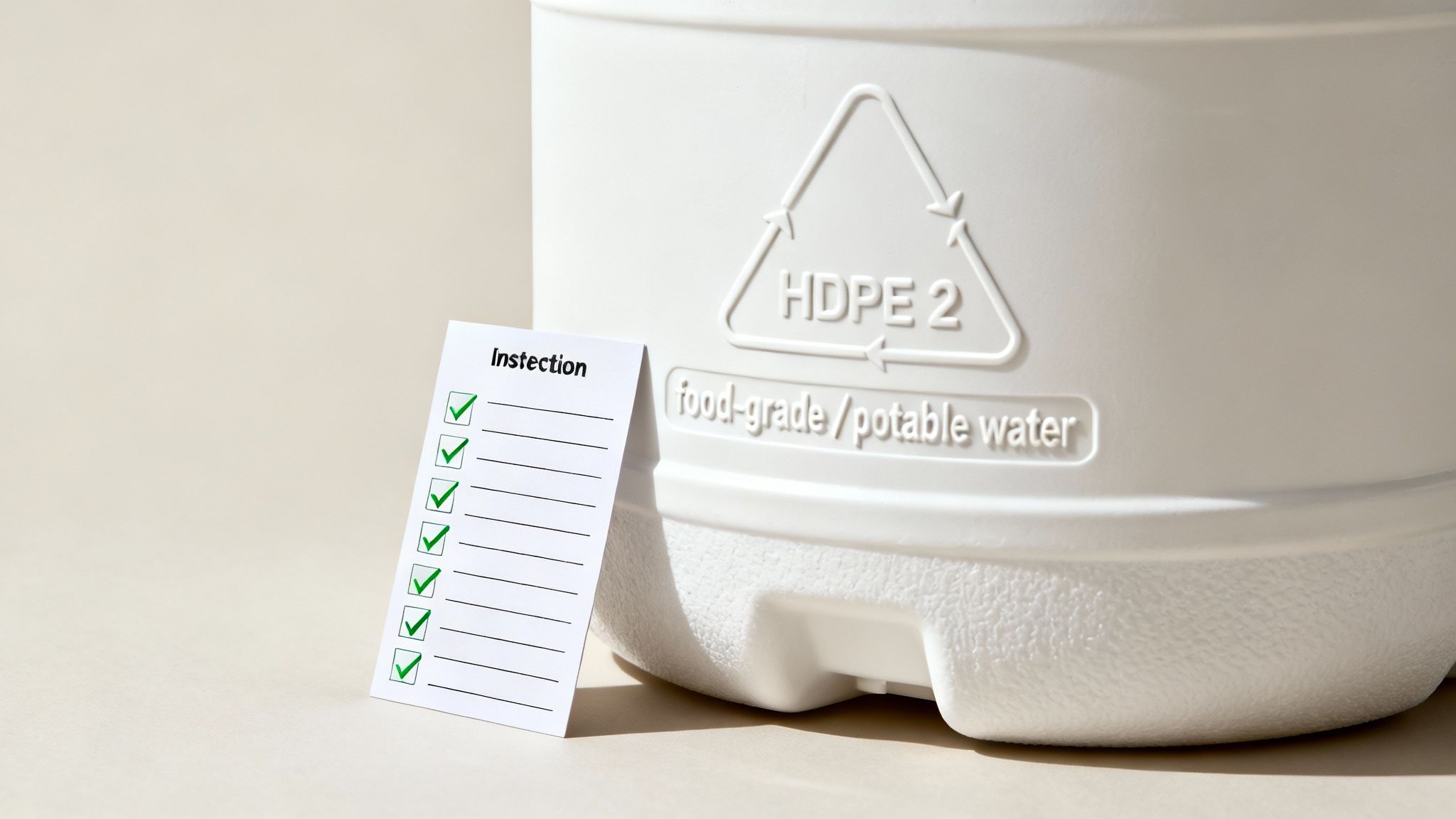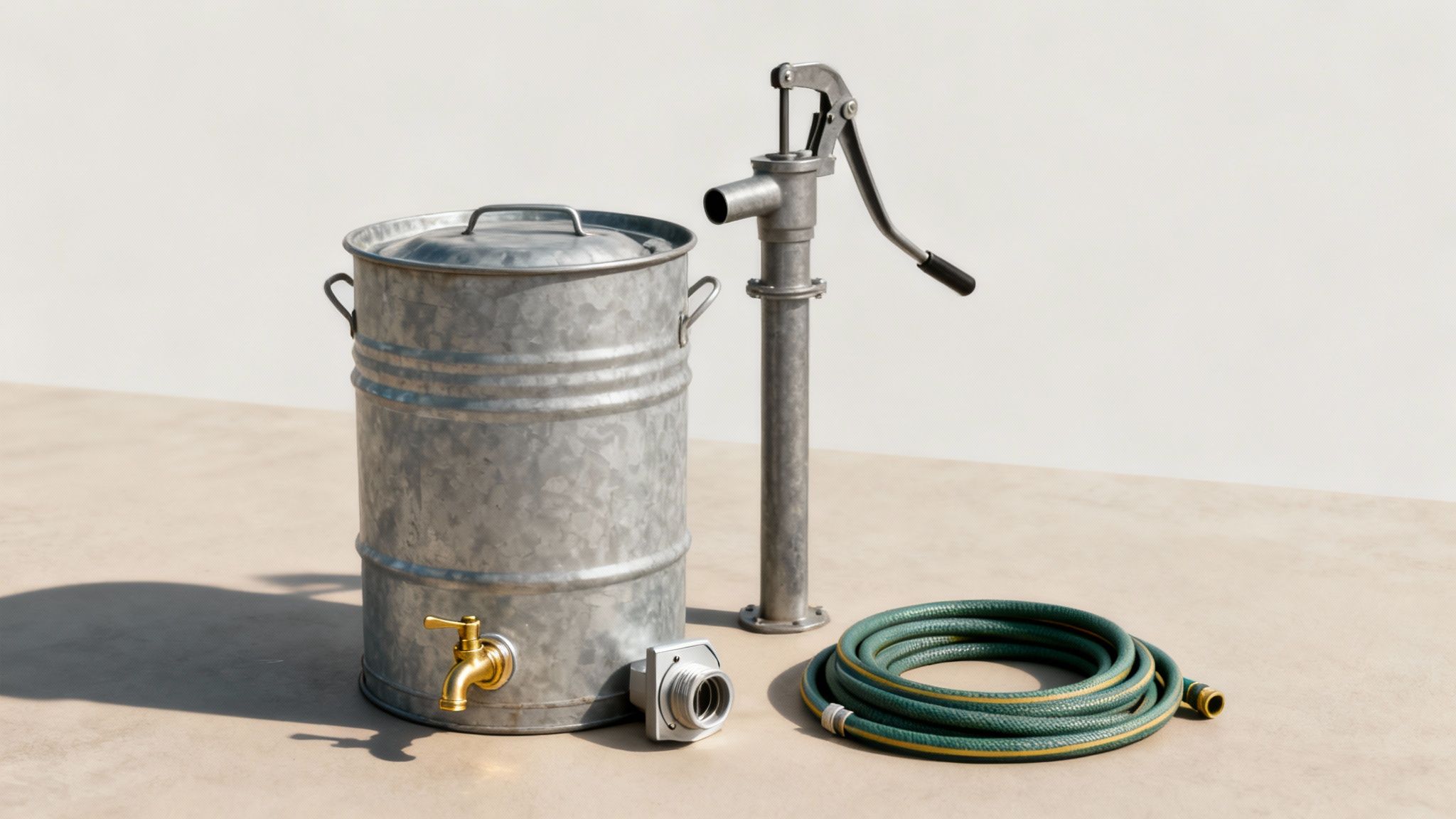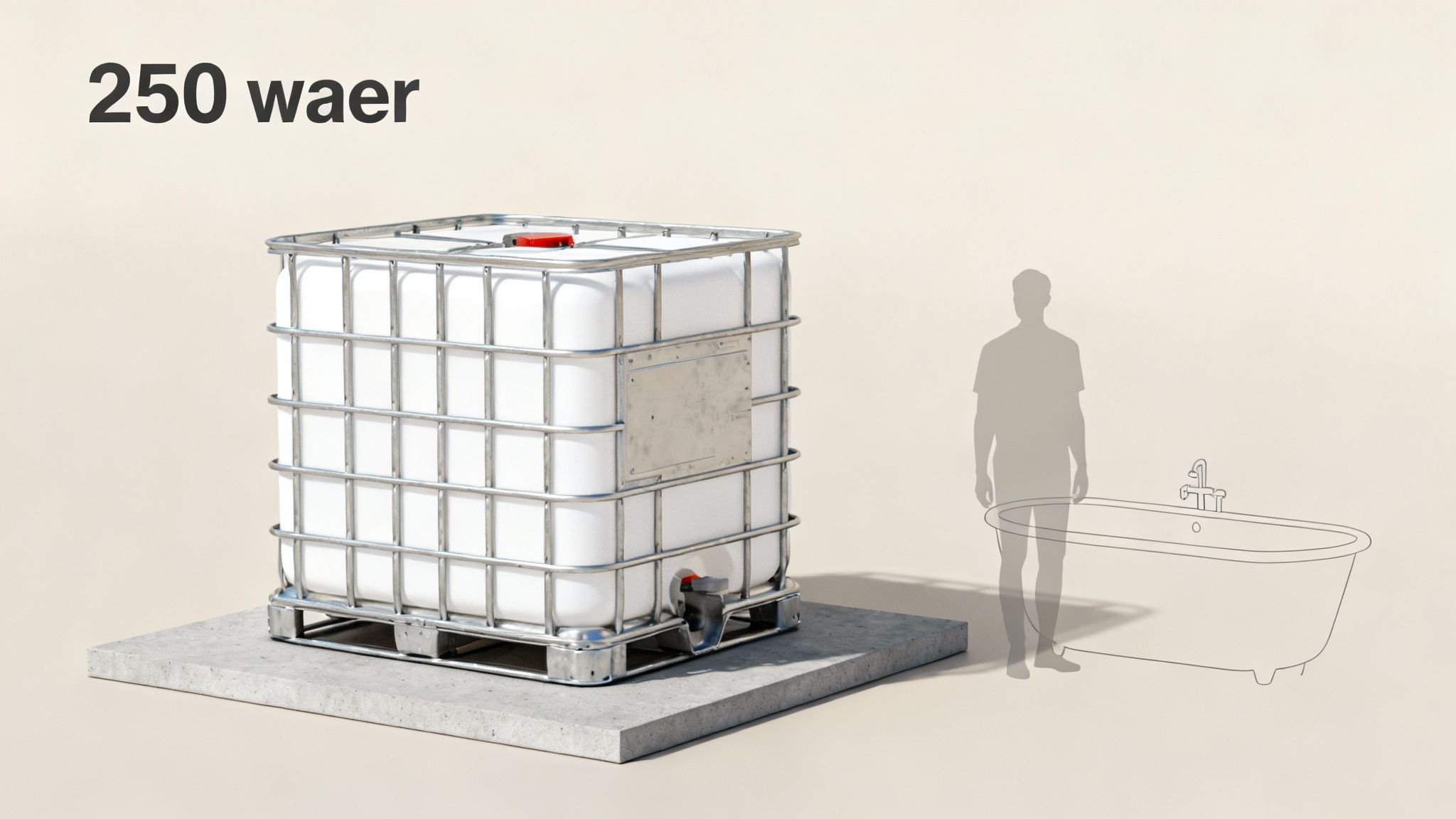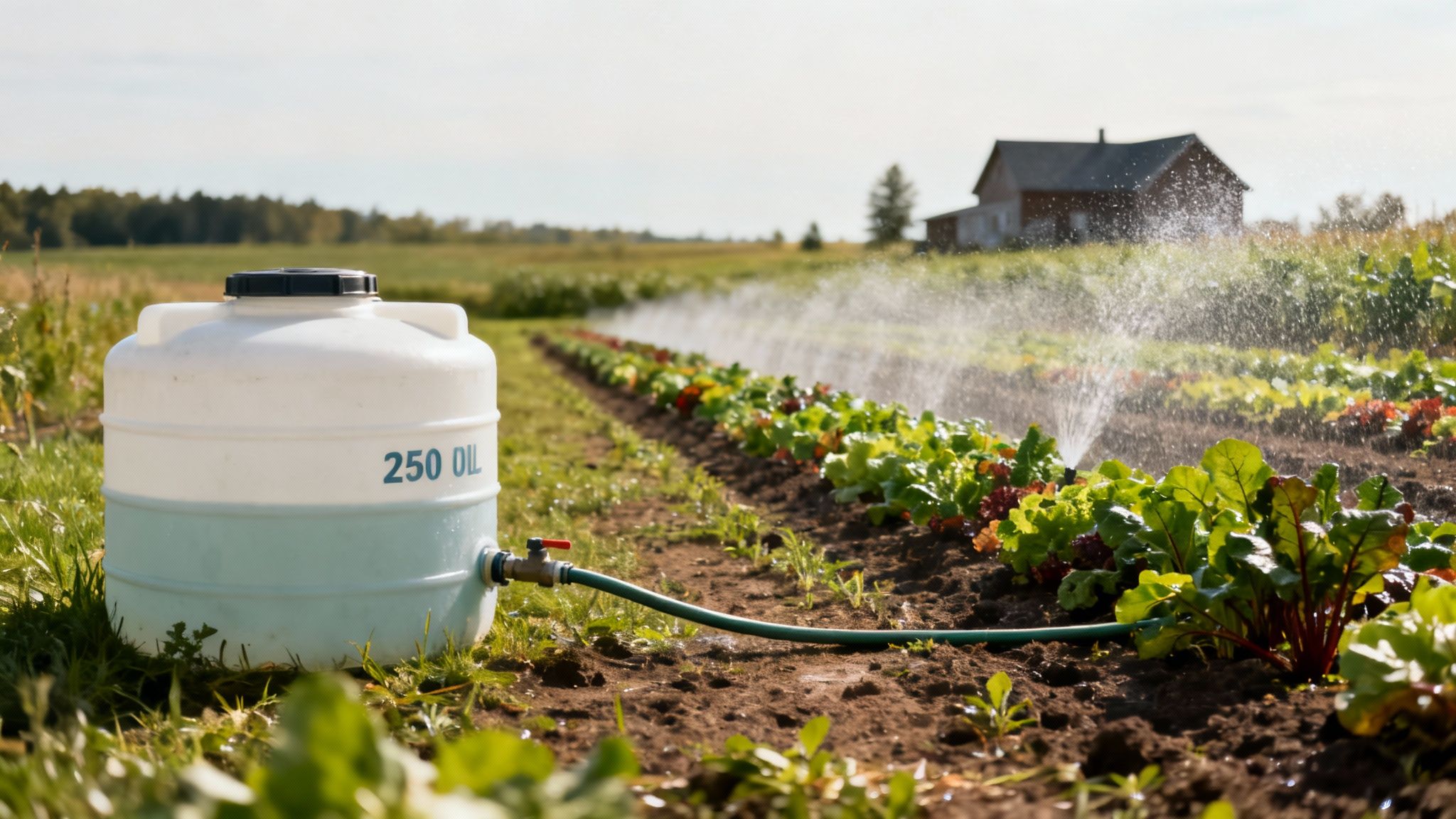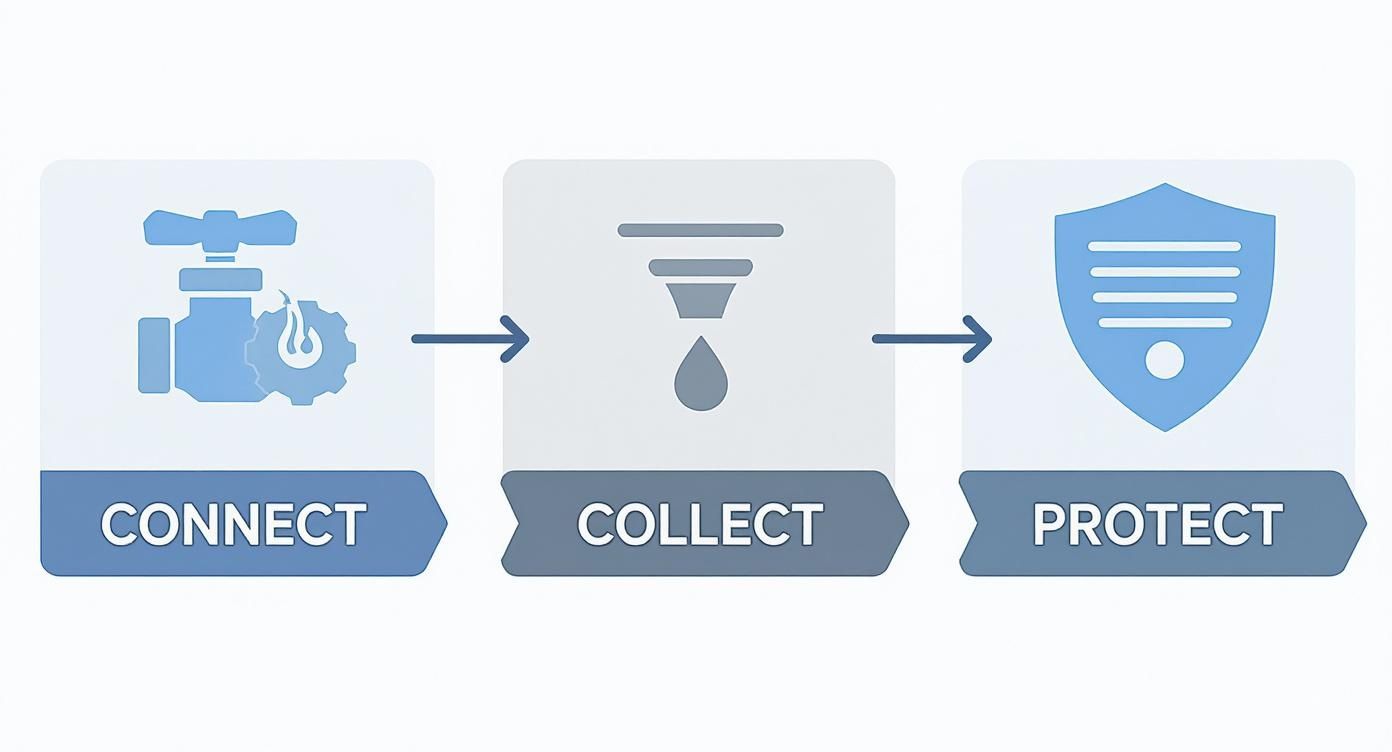Your cart is currently empty!
Tag: Water Storage
-

A Complete Guide to the 250 Gallon Water Tank
When you’re looking for a serious upgrade from a rain barrel but don't need a massive, permanent fixture, the 250 gallon water tank hits the perfect sweet spot. It’s what we in the industry call an Intermediate Bulk Container, or IBC, and it’s a workhorse for farms, construction sites, and even emergency water storage.
The Go-To Mid-Size Water Storage Solution

It can be tough to visualize what 250 gallons really means. Think of it this way: that’s enough water to fill about five regular bathtubs. It’s a substantial amount, offering a huge advantage in capacity without becoming a logistical nightmare to handle.
This tank strikes an ideal balance. It's a significant jump in volume from smaller containers but is still far more mobile and manageable than the huge stationary tanks you see at industrial plants. This versatility is exactly why it's become a favourite for everyone, from small-scale farmers needing to irrigate their fields to businesses that need water on the move.
Understanding the Specs: A Quick Glance
Before we dive deeper, let's get a clear picture of what we're working with. This table breaks down the essential numbers and what they mean in practical terms.
250 Gallon Water Tank At a Glance
Specification Typical Measurement Practical Equivalent Volume (US Gallons) 250 gal ~5 standard bathtubs Volume (Litres) 946 L ~946 one-litre water bottles Dimensions (L x W x H) ~48" x 40" x 35" Fits perfectly on a standard pallet Empty Weight 120 lbs (54 kg) Manageable for two people to lift Full Weight (Water) 2,200+ lbs (1,000+ kg) Roughly the weight of a small car Inner Material High-Density Polyethylene (HDPE) A tough, food-grade plastic Outer Cage Galvanized Steel Provides structural support and protection As you can see, the numbers tell a story. While it's light enough to handle when empty, you need to plan carefully for where it will sit once it’s full.
Built Smart: The Two-Part Design
A standard 250-gallon IBC isn't just a simple plastic box. Its design is a clever combination of materials, each playing a crucial role. The inner bottle is made from a tough, high-density polyethylene (HDPE), while the outer layer is a rigid, galvanized steel cage.
This composite structure is the secret to its success. You get the chemical resistance and seamless interior of the plastic liner, plus the strength and durability of the steel frame. It's a design that lets you stack and transport these tanks with confidence.
Why the Steel Cage Matters
That metal grid on the outside isn’t just for show—it’s the tank’s skeleton and armour all in one.
- It Provides Support: Water is incredibly heavy. The cage stops the inner plastic container from bulging or warping under all that pressure.
- It Protects the Tank: The cage acts like a bumper, shielding the inner bottle from accidental bumps, scrapes, and punctures during handling.
- It Allows for Stacking: The frame is strong enough to handle the weight of another full tank on top (usually stacked two-high), which is a huge space-saver.
This smart, robust design is precisely why the 250-gallon IBC is such a trusted water storage container. It’s the perfect blend of size, strength, and mobility, making it an incredibly efficient tool for managing water.
How Your Tank's Materials Impact Performance and Safety

When you're looking at a 250 gallon water tank, it’s easy to see it as just a simple container. But the materials used are a lot more thoughtful than that—they're the reason these tanks are so tough, reliable, and safe for everything from drinking water to industrial use. It all comes down to a clever two-part design: a high-tech inner bottle and a rugged outer cage.
At the core of every IBC tote is the inner container, which is almost always made from High-Density Polyethylene (HDPE). This isn't your average plastic. HDPE is a premium, food-grade material specifically chosen for its unique ability to safely hold liquids, especially potable water.
Think of that HDPE bottle as a pristine, sealed vault for your water. The most critical feature is that it's non-leaching, which means it won’t seep unwanted chemicals into the water over time. For anyone storing water for drinking, gardening, or livestock, this is the single most important safety guarantee.
The Power of High-Density Polyethylene
So, why HDPE? Beyond being food-safe, this powerhouse plastic brings a few other key benefits to the table, making it the go-to standard for the inner bottle of a 250 gallon water tank.
One of the biggest advantages is its built-in resistance to UV radiation. Direct sunlight is the enemy of stored water; it can break down lesser plastics and encourage algae to grow. The opaque, milky-white HDPE material acts as a natural sunblock, shielding the water from harmful rays. This not only keeps your water fresh but also helps the tank itself last much longer.
Key Takeaway: Using virgin, food-grade HDPE for the inner bottle is non-negotiable for safe drinking water storage. It’s your guarantee that the water stays as pure as the day you filled it, without any contamination from the container itself.
HDPE is also remarkably resistant to a whole host of chemicals. While we're focused on water here, this is what makes these tanks so versatile. You can confidently use them in agriculture for liquid fertilizers or on a job site for other non-hazardous liquids without worrying about the plastic degrading. When you're choosing a tank for potable water, it's worth exploring different types of plastic water storage tanks to see how different materials suit various needs.
The Unsung Hero: The Galvanized Steel Cage
If the HDPE bottle is the heart of the tank, the galvanized steel cage is its skeleton. This external frame provides the muscle and protection that the inner bottle just can't offer on its own. It's what turns a simple plastic container into a heavy-duty industrial tool.
The cage really has three main jobs:
- Structural Support: It keeps the inner bottle from bulging or warping under the immense pressure of 2,200 pounds of water.
- Impact Protection: On a busy farm or construction site, bumps and knocks are inevitable. The cage acts like a suit of armour, protecting the inner container from punctures and damage.
- Stackability: The frame is precisely engineered to handle the weight of another full tank on top, which is a lifesaver when you need to store a lot of water in a small footprint.
This tag-team approach—a safe, seamless inner bottle protected by a tough, structural cage—is what makes the 250 gallon water tank so incredibly effective. It’s the perfect blend of safety and sheer utility. For more specialized jobs, you might even find tanks with heavy-gauge steel cages and thick foam insulation, which can cut standby heat loss by 10 to 15% compared to standard models.
Real-World Uses for 250 Gallon Water Tanks

It’s easy to think of a 250 gallon water tank as just a box that holds water. But in reality, it’s a problem-solver. Out in the real world, these tanks are the unsung heroes on farms, construction sites, and even in suburban backyards.
What makes this size so useful is its perfect balance—it holds a serious amount of water, but it's still nimble enough to be moved around without a fuss. Let's dig into some of the most common ways people are putting these workhorses to good use.
Agriculture and Small-Scale Farming
For anyone running a small or mid-sized farm in Canada, water management is a constant puzzle. The 250 gallon water tank is a fantastic solution. It’s got enough capacity to make a real difference, yet it's compact enough to slide into the back of a pickup or onto a small trailer.
This mobility is a game-changer for daily farm tasks:
- Targeted Irrigation: Got a new patch of seedlings far from your main water line? Just haul the water directly to them. No more running hundreds of feet of hose.
- Livestock Watering: It's perfect for setting up temporary watering holes in different pastures, making rotational grazing a whole lot easier on you and your animals.
- Mixing and Spraying: The tough HDPE liner can handle liquid fertilizers or pesticides. You can mix a batch and take it right to the field where you need it, saving time and hassle.
Ultimately, the ability to put a good amount of water exactly where it's needed streamlines the whole operation. It’s a simple answer to a complex problem.
Construction and Job Site Support
Construction sites are constantly changing, and they almost never have running water from day one. That’s where a 250 gallon water tank becomes an essential piece of gear. It’s tough enough to take the bumps and scrapes of a busy site, too.
Here’s how crews put them to work:
- Dust Control: Keeping dust down is a must for safety and environmental rules. Hook up a simple spray nozzle, and you can easily mist down haul roads and work areas.
- Concrete and Mortar Mixing: You can't mix concrete without water. A tank on-site means you’re not held up waiting for a water truck or a permanent hookup.
- Equipment Wash-Down: At the end of the day, machinery needs cleaning. Connect a pressure washer, and you have a mobile wash station. A typical 4 GPM pressure washer could run for over an hour off a full tank.
On-the-Go Water Supply: Think of it as a mobile utility station. Having 250 gallons of water on hand prevents small logistical headaches from turning into big project delays. It just keeps things moving.
Emergency Preparedness and Backup Water
Whether you're dealing with a boil water advisory, a power outage that kills your well pump, or a more serious natural disaster, having a backup water supply is critical. For homeowners and communities, a 250 gallon water tank offers real security and peace of mind.
This isn't just a small reserve; it's a lifeline. To put it in perspective, let’s look at a water-conscious area. In early 2024, the average residential water use in California was about 61 gallons per person per day. A 250-gallon tank could supply one person with water for about four days. While Canadian water use varies, you can see how this volume could easily support a family through a short-term crisis. You can learn more about California's water conservation efforts to see how vital storage is.
And it’s not just for drinking. That water can be used for flushing toilets and basic hygiene, making an already stressful situation much more manageable.
Getting the Right Fittings and Accessories for Your Tank
A 250-gallon water tank is only as good as the parts you connect to it. Think of it this way: the tank itself is just the heart of your water system. The real magic happens with the fittings and accessories—the valves, adapters, and hoses that let you control the flow and get the water exactly where you need it.
Without the right connections, you’ve just got a big box of water. But with the right setup, it transforms into a precise tool for irrigation, an emergency water source, or a key part of your worksite. Getting this right might seem a little technical at first, but it really just boils down to matching the right parts to your tank and your job.
NPT vs. BSP: Don't Get Your Threads Crossed
This is where most people get tripped up. Before you buy a single adapter or valve, you have to know what kind of threads your tank has. Get it wrong, and you're guaranteed a slow, frustrating leak. The two standards you'll see are NPT and BSP, and they absolutely do not work together.
- NPT (National Pipe Thread): This is the go-to standard across North America, including here in Canada. NPT threads are tapered—they get a tiny bit narrower at the end. As you tighten them, they wedge together to create a seal, usually with a little help from some plumber's tape.
- BSP (British Standard Pipe): You'll find this type more common in Europe and other parts of the world. Unlike NPT, BSP threads are straight (or parallel). They don't rely on the threads to seal; instead, a small washer or gasket does the work.
Expert Tip: Double-check the thread type on your tank's valve before you order anything. Trying to force an NPT fitting onto a BSP valve (or vice-versa) is a recipe for a bad connection that will drip constantly or even pop off under pressure.
Must-Have Accessories to Get the Most Out of Your Tank
Once you've figured out your threads, you can start looking at the gear that will make your 250-gallon water tank easy to use. These are the parts that make filling, emptying, and connecting a quick and painless process.
Here are a few accessories we see our customers use all the time:
- Valves and Adapters: Your tank comes with its own valve, but you’ll almost certainly need an adapter to connect it to anything useful. For most people in Canada, an NPT adapter is what you’ll need to hook up a standard garden hose or other common plumbing lines.
- Camlock Fittings: If you need to connect and disconnect hoses quickly and often—say, on a farm or a construction site—camlocks are fantastic. They let you snap a hose on or off in seconds, with no tools required. It's a real time-saver.
- Downspout Diverters: For anyone setting up a rainwater harvesting system, a downspout diverter is essential. This clever device fits onto your eavestrough’s downspout. It sends rainwater into your tank until it's full, then automatically switches back to draining normally.
Tank Heaters: A Smart Move for Canadian Winters
Using a 250-gallon water tank anywhere in Canada means you have to think about winter. When water freezes, it expands with incredible force—enough to crack the inner plastic bottle or split the valve wide open. That means expensive repairs and a whole lot of wasted water.
A tank heater is the best way to prevent this headache. These aren't meant to boil the water, just to keep it safely above freezing without running up a massive hydro bill. It’s a small investment that protects your tank and guarantees you have usable water all year long, which is critical if you're watering livestock or keeping an emergency supply ready through the cold months.
Getting Your Tank Set Up Right: Installation and Maintenance
To get the most out of your 250 gallon water tank, you need to think about its longevity right from day one. A solid installation and a simple, consistent maintenance routine are what separate a reliable water source from a future headache. It’s all about protecting your investment and ensuring the water inside stays clean and ready to use.
Think of it this way: a poor setup can lead to instability, leaks, or even total failure down the road. Likewise, skipping basic upkeep, especially with our tough Canadian seasons, can invite contamination or damage. A little prep work now saves a lot of trouble later.
A Solid Foundation is Non-Negotiable
This is the single most important step in setting up your 250 gallon tank. When full, this tank is holding over 2,200 pounds (1,000 kg) of water. That’s about the weight of a small car sitting in one spot. The ground underneath has to be ready to handle that load without shifting or sinking.
The two magic words here are solid and level. An uneven base puts a huge amount of stress on the tank’s cage and plastic bottle, which is a recipe for cracks and structural damage.
Here are a few great, reliable options for a base:
- Compacted Gravel or Crusher Dust: Laying down a 4- to 6-inch pad of compacted gravel creates a firm, well-draining surface.
- Concrete Slab: If you're looking for a permanent, set-it-and-forget-it solution, a reinforced concrete pad is the best you can get.
- Paving Stones: Tightly packed interlocking pavers laid over a sand base are another solid choice.
A Quick Word of Warning: Whatever you do, don't just place your tank on soft dirt or an uneven patch of grass. The sheer weight of the water will cause it to tilt and sink, creating a serious safety hazard and likely ruining your tank.
A Year-Round Plan for Peak Performance
Once your tank is securely in place, a little bit of upkeep is all it takes to keep it in prime condition. Regular checks are your best defence against small issues turning into big, expensive problems.
A seasonal approach works perfectly. Canadian weather throws a bit of everything at us—from intense summer sun to deep winter freezes—and your maintenance should reflect that. This simple checklist will guide you through the essentials, ensuring your tank and the water inside are always in good shape.
Seasonal Maintenance Checklist for Your Water Tank
Season Maintenance Task Purpose Spring Inspect for any cracks or damage from winter ice. Check that all valves and fittings are tight and leak-free. Give the tank a thorough cleaning. To catch any winter-related damage early and prepare the tank for the high-use season ahead. Summer Check for algae growth, especially if the tank is in direct sunlight. Ensure the lid is securely fastened to keep out debris and pests. To maintain water quality during warm months when algae and bacteria are more likely to grow. Autumn Clear away any leaves or debris from the top and around the base of the tank. If in a freezing zone, consider draining it or installing a tank heater. To prevent organic matter from contaminating the water and to prepare for freezing temperatures. Winter Regularly check for ice buildup around the valve, which can cause damage. If the tank is in use, ensure your heating system is functioning. To prevent the valve from freezing solid and cracking, ensuring the tank remains usable and intact. This small amount of effort pays off big time by extending the life of your tank and giving you peace of mind.
This flow chart breaks down how all the key parts—from valves to heaters—work together to connect, collect, and protect your water.

As you can see, a truly functional system is more than just the tank itself. The right accessories are what make it work seamlessly.
Keeping It Clean: Best Practices for Upkeep
Keeping your 250 gallon water tank clean is essential, especially if you’re using the water for your garden, livestock, or as an emergency backup. Over time, algae and sediment can build up and foul the water. We recommend a good clean-out at least once a year.
Here’s a straightforward process to get it done:
- Drain It Completely: Just open the valve and let all the water out.
- Give It a Scrub: Using a long-handled brush and a simple mix of mild soap and water, scrub the inside walls and floor. Be sure to avoid harsh chemicals, as they can damage the HDPE plastic.
- Rinse It Out: A pressure washer or a hose with good pressure is perfect for rinsing out all the soap residue. Keep rinsing until the water runs clear.
- Let It Air Dry: If you can, leave the top lid open and let the inside air dry completely before you fill it back up.
By sticking to these simple installation and maintenance tips, you’ll ensure your tank operates safely and effectively for years to come. And if your primary goal is storing drinking water, remember that it all starts with choosing the right container from the get-go. You can learn more about the specific requirements in our guide to potable water storage tanks.
Frequently Asked Questions
When you're looking into a 250-gallon water tank, a few questions are bound to pop up, especially if you're planning a project or setting one up for the first time. Getting the right answers makes all the difference in using your tank safely and effectively.
We’ve put together some of the most common questions our customers ask us. The goal here is to give you straightforward, practical information, whether this is your first tank or you've been using them for years.
How Long Can I Safely Store Potable Water?
When you’re storing water for drinking, safety and freshness are everything. The good news? In a clean, food-grade HDPE tank, properly treated water can last for quite a while.
As a general rule, you can safely store potable water for up to 6 months. To keep it tasting fresh, it's a good idea to get into the habit of rotating your supply. Just empty the tank and refill it with fresh water twice a year. This simple step stops the water from going stale.
If you’re planning on storing water for longer than six months, a water treatment solution is a must. A few drops of chlorine or a specially designed water preserver, used according to the label, will stop any bacteria from growing and keep your water safe to drink.
Can I Stack Multiple 250 Gallon Tanks?
Yes, you can! The strong, galvanized steel cage that wraps around a standard 250-gallon water tank is built for exactly that. It’s a huge plus when you need to store more liquid without taking up extra floor space.
But you have to do it safely. The standard guideline is to stack full tanks no more than two high. This limit ensures the whole setup stays stable and doesn’t put too much pressure on the bottom tank’s frame.
A Crucial Safety Note: Always stack your tanks on a perfectly level and solid surface, like a concrete pad. Trying to stack on uneven ground is asking for trouble. And never, ever stack a full tank on top of one that shows any signs of damage, like bent cage bars or dents. Empty tanks, on the other hand, can often be stacked higher, but always check the manufacturer’s guidelines first.
What Is the Difference Between New, Reconditioned, and Used?
Getting the lingo right for IBC totes is key to buying the right tank for your job, especially when safety and water quality are on the line. "New," "reconditioned," and "used" all mean very different things.
Here’s a simple breakdown:
- New Tank: This is a unit that’s fresh from the factory. Both the inner plastic bottle and the outer steel cage have never been touched or used. A new tank is your best bet for storing drinking water or food-grade liquids where you can't risk any contamination.
- Reconditioned (or Rebottled) Tank: This is often the sweet spot for value. It combines a brand-new, untouched plastic bottle with a professionally cleaned, inspected, and certified used cage. You get the same safety as a new tank for potable water, but at a friendlier price point.
- Used Tank: With a used tank, both the inner bottle and the outer cage have held something before. Since it’s often impossible to know what was in there, used tanks are not safe for drinking water, watering your vegetable garden, or for livestock. They are, however, a great, cost-effective option for non-potable uses like dust control on a construction site or storing certain industrial chemicals.
Do I Need a Permit to Install a Tank in Canada?
That’s a great question, and the answer really depends on where you live and what you’re using the tank for. For most common residential uses, like setting up a rainwater barrel for your garden, you usually won't need a permit for a 250-gallon water tank.
However, Canadian regulations can be very different from one municipality to another, and even between provinces. The rules tend to get stricter for commercial use or if you plan on connecting the tank to your home’s plumbing. For instance, tying it into your home's main water supply would almost certainly require a permit and a professional plumber to meet local building and health codes.
Your best bet is to play it safe. A quick call to your local municipal building or planning department can clear things up. They’ll tell you about the specific by-laws in your area and confirm if you need a permit for your setup, giving you peace of mind before you start.
Ready to find the perfect water storage solution for your farm, business, or home? At IBC Tanks Canada, we offer a complete range of new, reconditioned, and rebottled IBCs to meet your exact needs. Explore our selection of high-quality 250-gallon tanks and all the essential accessories by visiting us at https://ibctanks.ca.




